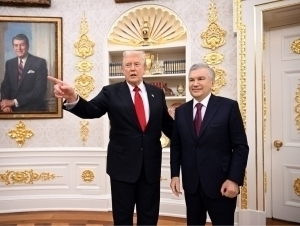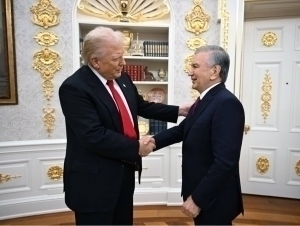Tashkent to revive its historic Tram System with French partnership
Review
−
18 March 8201 7 minutes
Trams will return to Tashkent once again. This was reported by journalist Aziza Kurbanova, who participated in the signing ceremony of interdepartmental documents at the French Ministry of Foreign Affairs. It is noted that Deputy Mayor of Tashkent Sharof Rakhmonov and French Minister-Delegate for Foreign Trade and Citizens Abroad Laurent Saint-Martin signed a roadmap for the implementation of the tram system.
Despite several days passing since the signing of the document, the Tashkent government has not made any public statement about this project, which it signed and which holds great significance for the city's future. When contacted, the Ministry of Transport stated that this project was signed at the government level and that they would be responsible for its implementation.
About the Trams That Are Expected to Be Rebuilt
If you recall, nine years ago, in 2016, the Tashkent tram system, which had a century-long history, was shut down. The oldest and largest tram network in Central Asia, serving the capital’s residents for many years, was initially launched on December 29, 1912. However, this achievement was not instantaneous. The agreement for the construction and operation of a tram system in Tashkent was signed 16 years earlier, in 1896, between city officials and Belgian businessman Eduard Empen.
Tramlines that had served Tashkent residents for a century began closing one by one in the 2000s. In 2008, three tram lines were shut down simultaneously, reducing the number of routes to 11. The closures continued until 2016 when, on March 28, then-mayor Rakhmonbek Usmanov announced the complete termination of tram services.
This decision was made due to the increasing number of motor vehicles, the lack of street network development, and the perceived inefficiency of tram routes. On May 2, the last tram of Route 17 entered the depot, marking the end of Tashkent’s 115-year tram history. At that time, only seven tram routes remained operational. It was announced that new bus routes would replace the discontinued trams.
Following the closure, many Tashkent residents boarded the trams for one last ride, taking photos and sharing their memories on social media. Activists argued that significant time and resources had been invested in the tram system and that it was the best mode of public transport for the capital.
Efforts to Rebuild
When tram lines were shut down in 2016, a social media user wrote:
"Perhaps in a few years, the next Tashkent officials will realize that they made a big mistake and decide to rebuild the tram lines and buy trams to protect the environment."
And that’s exactly what happened. Six years after the closure, discussions about bringing trams back to the capital began. But what is driving this revival of the abandoned and “erased” tram system? According to President Shavkat Mirziyoyev, it’s the people’s demand. During his visit to Samarkand in February 2022, Mirziyoyev specifically mentioned the presence of a tram in the city and stated:
"We want to bring the tram back to Tashkent as well. We are receiving many letters and appeals from citizens on this matter."
In March 2024, Transport Minister Ilhom Mahkamov emphasized that the tram is "an extremely necessary infrastructure" and that efforts were underway to connect the capital with New Tashkent, as well as to establish tram routes within the city. Speaking about the complete suspension of trams in 2016, Mahkamov noted that he was working in a different sector at the time.
"Now, as a representative of the industry, I can say that the tram is an extremely necessary infrastructure for the city of Tashkent. The cancellation of the existing tram… maybe, I think, at that time there were not so many traffic jams, there was no appeal, no need. There must have been good reasons for that at that time. Even otherwise, it would have been necessary to modernize and renew it. Both the trams themselves and the tracks were built in the old way. We need this infrastructure," he said.
It is worth noting that the recently signed tram construction roadmap is the second agreement on this matter. The first was signed in November 2022 by Deputy Prime Minister and Minister of Investments and Foreign Trade Jamshid Khojayev and French Minister of Foreign Trade, Economic Attraction, and Citizens Abroad Olivier Bechte during President Mirziyoyev's visit to France. According to this agreement, the French engineering company Alstom was to build a 9.1 km tram line in Tashkent, designed to transport 78,000 passengers per day.
The construction of the 167.4 million euro project was scheduled to begin in the second quarter of 2024. But, but, but...
Why Was the First Roadmap Not Implemented?
For reasons unknown to the public, the agreement never materialized. However, efforts to restore the tram system continued. During President Mirziyoyev’s recent visit to France, a new "roadmap" for tram construction was signed—this time by city authorities rather than ministries. The signatories included Deputy Mayor of Tashkent Sharof Rakhmonov and French Minister-Delegate for Foreign Trade and Citizens Abroad Laurent Saint-Martin. QALAMPIR.UZ attempted to obtain further details from the city administration, but no information was provided. As a result, key details such as the cost of the project, the planned route distances, and the tram models remain unknown.
A logical question arises: Why didn’t construction begin after the first agreement?
Interestingly, on May 2, 2023, just 1-2 months before construction was supposed to start, Alstom Vice President Sacha Parne stated at an international investment forum in Tashkent that Uzbek officials preferred to build the tram system in New Tashkent. However, he did not rule out the possibility of constructing tram lines in the capital itself.
Previously, Minister Mahkamov had responded to a question about whether trams would return to Tashkent shortly by saying:
"Of course, no one has the idea that there will be no tram in Tashkent, we have stopped this, this is clear, we are far from it. We are working on the issue of which routes to put the tram. In this, we must proceed from the existing infrastructure."
Urban Planning Perspectives on Trams
Urban planning experts emphasize that the tram system, despite its previous inefficiencies, remains a viable and modern form of public transport. Some argue that tram lines previously occupied separate lanes, causing cracks in the city's asphalt roads, but modern technology allows tracks to be built at the same height as roads.

"If this is done, other wheeled transport will not be affected. Trams can pass not only on roads but also through areas where car traffic is restricted or prohibited. A modern tram is the greenest, most capacious transport in modern, sustainable cities. For example, while a two-section bus can carry up to 120 passengers, the capacity of a tram can exceed 200 passengers," says architect Ibrohim Dostmuhammadov.
According to him, when properly designed—not just technically, but also from an urban planning perspective—the tram system can serve the best interests of the city’s population.
It Is Necessary to Demolish to Build Again…
Some residents of Tashkent may wonder, “Will the roads be demolished again to build tram lines?” However according to Dostmuhammadov, the tram is worth the effort.
"During construction, work is carried out on the road, but roads are often closed for less significant reasons, such as pipe replacements," he noted in an interview with QALAMPIR.UZ.
Minister Mahkamov also acknowledged the potential inconvenience of construction, stating:
"Now experts are telling us that we should start by building a line connecting the ‘old’ and New Tashkent. They say that if we start building a tram in the city now, we will also encounter traffic jams. Not after the tram is launched, but during construction. This will take a very long time."
In conclusion, it can be said that shortsighted decision-making by past leaders has had a lasting impact on the city and its residents.
Live
All



